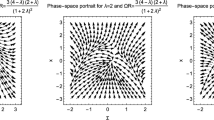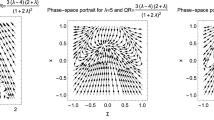Abstract
We investigate the cosmology of a class of model with noncanonical scalar field and matter in an anisotropic time dependent background. Writing the Einstein Equations in terms of dimensionless dynamical variables appropriately defined for bouncing solutions, we find all the fixed points. While evolving the dynamical variables to their stable fixed points numerically, solutions satisfying non singular bounce are found.






Similar content being viewed by others
References
Arkani-Hamed, N., Cheng, H.-C., Luty, M.A., Mukohyama, S.: Ghost condensation and a consistent infrared modification of gravity. J. High Energy Phys. 0405, 074 (2004). hep-th/0312099
Battefeld, T.J., Patil, S.P., Brandenberger, R.: Non-singular perturbations in a bouncing brane model. Phys. Rev. D 70, 066006 (2004). hep-th/0401010
Belinsky, V.A., Khalatnikov, I.M., Lifshitz, E.M.: Oscillatory approach to a singular point in the relativistic cosmology. Adv. Phys. 19, 525 (1970)
Bertacca, D., Bartolo, N., Matarrese, S.: Unified dark matter scalar field models. Adv. Astron. 2010, 904379 (2010). arXiv:1008.0614 [astro-ph.CO]
Bose, N., Majumdar, A.S.: A k-essence model of inflation, dark matter and dark energy. Phys. Rev. D 79, 103517 (2009a). arXiv:0812.4131 [astro-ph]
Bose, N., Majumdar, A.S.: Unified model of k-inflation, dark matter and dark energy. Phys. Rev. D 80, 103508 (2009b). arXiv:0907.2330 [astro-ph.CO]
Brandenberger, R.H.: Alternatives to cosmological inflation. arXiv:0902.4731 [hep-th] (2009)
Brandenberger, R.H.: Cosmology of the very early universe. AIP Conf. Proc. 1268, 3–70 (2010a). arXiv:1003.1745 [hep-th]
Brandenberger, R.H.: Introduction to early universe cosmology. In: PoS, vol. ICFI2010, 001 (2010b). arXiv:1103.2271 [astro-ph.CO]
Brandenberger, R.H.: The matter bounce alternative to inflationary cosmology. arXiv:1206.4196 [astro-ph.CO] (2012)
Brandenberger, R., Finelli, F.: On the spectrum of fluctuations in an effective field theory of the ekpyrotic universe. J. High Energy Phys. 0111, 056 (2001). arXiv:hep-th/0109004
Buchbinder, E.I., Khoury, J., Ovrut, B.A.: New ekpyrotic cosmology. Phys. Rev. D 76, 123503 (2007). hep-th/0702154
Cai, Y.-F., Easson, D.A., Brandenberger, R.: Towards a nonsingular bouncing cosmology. J. Cosmol. Astropart. Phys. 1208, 020 (2012a). arXiv:1206.2382 [hep-th]
Cai, Y.-F., Easson, D.A., Brandenberger, R.: Anisotropy in a nonsingular bounce. Class. Quantum Gravity 1208, 020 (2012b). arXiv:1301.4703 [gr-qc]
Chiba, T., Okabe, T., Yamaguchi, M.: Kinetically driven quintessence. Phys. Rev. D 62, 023511 (2000). astro-ph/9912463
Copeland, E.J., RLiddle, A., Wands, D.: Exponential potentials and cosmological scaling solutions. Phys. Rev. D 57, 4686 (1998). gr-qc/9711068
Copeland, E.J., Sami, M., Tsujikawa, S.: Dynamics of dark energy. Int. J. Mod. Phys. D 15, 1753 (2006). hep-th/0603057
Creminelli, P., Senatore, L.: A smooth bouncing cosmology with scale invariant spectrum. J. Cosmol. Astropart. Phys. 0711, 010 (2007). hep-th/0702165
De-Santiago, J., Cervantes-Cota, J.L.: Generalizing a unified model of dark matter, dark energy, and inflation with non canonical kinetic term. Phys. Rev. D 83, 063502 (2011). arXiv:1102.1777 [astro-ph.CO]
De-Santiago, J., Cervantes-Cota, J.L., Wands, D.: Phys. Rev. D 87, 023502 (2013). arXiv:1204.3631 [gr-qc]
Erickson, J.K., Wesley, D.H., Steinhardt, P.J., Turok, N.: Kasner and mixmaster behavior in universes with equation of state \(w \geq1\). Phys. Rev. D 69, 063514 (2004). hep-th/0312009
Finelli, F.: Assisted contraction. Phys. Lett. B 545, 1 (2002). hep-th/0206112
Finelli, F., Brandenberger, R.: On the generation of a scale-invariant spectrum of adiabatic fluctuations in cosmological models with a contracting phase. Phys. Rev. D 65, 103522 (2002). arXiv:hep-th/0112249
Garfinkle, D., Lim, W.C., Pretorius, F., Steinhardt, P.J.: Phys. Rev. D 78, 083537 (2008). arXiv:0808.0542 [hep-th]
Hwang, J.c.: Cosmological structure problem in the ekpyrotic scenario. Phys. Rev. D 65, 063514 (2002). arXiv:astro-ph/0109045
Khoury, J., Ovrut, B.A., Steinhardt, P.J., Turok, N.: The ekpyrotic universe: Colliding branes and the origin of the hot big bang. Phys. Rev. D 64, 123522 (2001). arXiv:hep-th/0103239
Khoury, J., Ovrut, B.A., Seiberg, N., Steinhardt, P.J., Turok, N.: From big crunch to big bang. Phys. Rev. D 65, 086007 (2002a). arXiv:hep-th/0108187
Khoury, J., Ovrut, B.A., Steinhardt, P.J., Turok, N.: Density perturbations in the ekpyrotic scenario. Phys. Rev. D 66, 046005 (2002b). arXiv:hep-th/0109050
Lehners, J.-L.: Ekpyrotic and cyclic cosmology. Phys. Rep. 465, 223 (2008). arXiv:0806.1245 [astro-ph]
Lehners, J.-L., McFadden, P., Turok, N., Steinhardt, P.J.: Generating ekpyrotic curvature perturbations before the big bang. Phys. Rev. D 76, 103501 (2007). hep-th/0702153
Lyth, D.H.: The primordial curvature perturbation in the ekpyrotic universe. Phys. Lett. B 524, 1 (2002a). arXiv:hep-ph/0106153
Lyth, D.H.: The failure of cosmological perturbation theory in the new ekpyrotic scenario. Phys. Lett. B 526, 173 (2002b). arXiv:hep-ph/0110007
Martin, J., Peter, P., Pinto Neto, N., Schwarz, D.J.: Passing through the bounce in the ekpyrotic models. Phys. Rev. D 65, 123513 (2002). hep-th/0112128
Martin, J., Peter, P., Pinto Neto, N., Schwarz, D.J.: Comment on “Density perturbations in the ekpyrotic scenario”. Phys. Rev. D 67, 028301 (2003)
Mukhanov, V.F., Vikman, A.: Enhancing the tensor-to-scalar ratio in simple inflation. J. Cosmol. Astropart. Phys. 0602, 004 (2006). astro-ph/0512066
Notari, A., Riotto, A.: Isocurvature perturbations in the ekpyrotic universe. Nucl. Phys. B 644, 371 (2002). hep-th/0205019
Panotopoulos, G.: Detectable primordial non-gaussianities and gravitational waves in k-inflation. Phys. Rev. D 76, 127302 (2007). arXiv:0712.1713 [astro-ph]
Tolley, A.J., Turok, N., Steinhardt, P.J.: Cosmological perturbations in a big crunch/big bang space-time. Phys. Rev. D 69, 106005 (2004). hep-th/0306109
Unnikrishnan, S., Sahni, V., Toporensky, A.: Refining inflation using non-canonical scalars. J. Cosmol. Astropart. Phys. 1208, 018 (2012). arXiv:1205.0786 [astro-ph.CO]
Xue, B., Steinhardt, P.J.: Unstable growth of curvature perturbation in non-singular bouncing cosmologies. Phys. Rev. Lett. 105, 261301 (2010). arXiv:1007.2875 [hep-th]
Xue, B., Steinhardt, P.J.: Evolution of curvature and anisotropy near a nonsingular bounce. arXiv:1106.1416 [hep-th] (2011)
Author information
Authors and Affiliations
Corresponding author
Appendix
Appendix
1.1 A.1 Stability analysis of fixed points
The stability of a fixed point is determined from the behaviour of a small perturbation around that fixed point. We get the set of fixed points \(\tilde{x}_{c}\), \(\tilde{y}_{c}\), \(\tilde{z}_{c}\) and \({\sigma}_{c}\) by solving the set of Eqs. (20) simultaneously (where the subscript \(c\) denotes fixed points). Now, if we define the slopes of the dynamical variables \(\tilde{x}\), \(\tilde{y}\), \(\tilde{z}\) and \({\sigma }\) as \(f(\tilde{x},\tilde{y},\tilde{z},\sigma)\), \(g(\tilde{x},\tilde {y},\tilde{z},\sigma)\), \(h(\tilde{x}, \tilde{y},\tilde{z},\sigma)\) and \(i(\tilde{x},\tilde{y},\tilde{z},\sigma)\). The set of equations we need to solve to obtain the fixed point is
where,
The corresponding fixed point for \(\tilde{\varOmega}_{m}\) can be found using the constraint Eq. (12).
The stability of the fixed points can be examined from the evolution of small perturbations around fixed points. Now, if \((\tilde{x}_{c}, \tilde{y}_{c}, \tilde{z}_{c}, {\sigma}_{c})\) is a fixed point and \(\delta\tilde{x}= \tilde{x}-\tilde{x}_{c}\), \(\delta\tilde {y}=\tilde{y}-\tilde{y}_{c}\), \(\delta\tilde{z}= \tilde{z}-\tilde{z}_{c}\) and \(\delta\sigma= \sigma -\sigma_{c}\) be the respective perturbation around it, then the evolution of the perturbation is determined by
The evolution equations, up to first order, for these perturbations are
where the matrix is
is the Jacobian matrix and is evaluated at the fixed point \((\tilde {x}_{c},\tilde{y}_{c},\tilde{z}_{c},\sigma_{c})\) and hence each entry of \(\mathbf{A}\) is a number. The solution of the system of equations can be found by diagonalizing the matrix \(\mathbf{A}\). A non trivial solution exists only when the determinant \(| \mathbf{A}- \lambda\mathbf{I}|\) is zero. Thus, solving this equation in \(\lambda\) we would get all the eigen values of the system corresponding to each fixed points.
Rights and permissions
About this article
Cite this article
Panda, S., Sharma, M. Anisotropic bouncing scenario in \(F(X)-V(\phi)\) model. Astrophys Space Sci 361, 87 (2016). https://doi.org/10.1007/s10509-015-2594-y
Received:
Accepted:
Published:
DOI: https://doi.org/10.1007/s10509-015-2594-y




